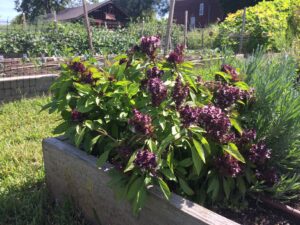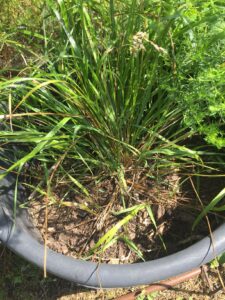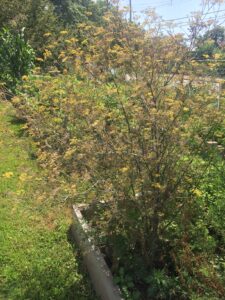Four Herbs to Grow When You’re Tired of Parsley


Matt Even, Outreach Coordinator of Gateway Greening, loves trying to grow new and exciting plants at the Demonstration Garden. He wants to use the space and lack of pressure to produce food that growing plants at the Demonstration Garden gives to try innovative things that might flourish or fail. During Spring 2017, he planted uncommon herbs to test what is possible to grow in the St. Louis region.
Tulsi (Holy Basil)
Tulsi is an herb that is native to India and grows best in tropic and subtropic climates. In its native habitat it is a perennial, but it can be grown as an annual in Northern regions, such as St. Louis. Tulsi is largely grown for its medicinal properties, culinary attributes, and uses in Hindu religious ceremonies. Many people drink it in a tea, which is high in antioxidants and said to support the immune system. Matt said that the Tulsi is the Demonstration Garden is doing quite well and that he will probably plant it next year. It’s definitely a good choice for St. Louis gardens.
For more information on how to grow Tulsi, click here.

Sweetgrass
Sweetgrass is also an herb used in ceremonial and religious contexts. It is native to North America and Europe and is especially significant for many Native American tribes as a result of its use as incense. Sweetgrass is a perennial herb that can produce extraordinary yields when cared for correctly. It is traditionally harvested, dried, and then braided, which is the form it is usually found in stores. The plant has a vanilla-like aroma that is especially strong when burned. Like Tulsi, the sweetgrass that was planted in the Demonstration Garden has grown very well and would be very appropriate for St. Louis gardens.
For more information on how to grow sweetgrass, click here.

Angelica
Angelica has been commonly used as a flavoring agent in many types of liquors, such as gin and vermouth. It is native to Europe and prefers cool climates as it is a heat-sensitive plant. The angelica in the Gateway Greening Demonstration Garden has not done as well as it could have because of the hot summers that St. Louis typically experiences. Unlike many herbs, Angelica actually prefers moist soil, which is something to keep in mind if the plant makes its way to your garden. It is definitely a plant that requires extra attention in the St. Louis region. Unless you have the time to devote to caring for Angelica, it should not be your top choice for planting.
For more information on how to grow angelica, click here.

Lovage
A perennial edible that has a flavor between celery and parsley, Lovage is a tried and true choice for St. Louis region gardens. It also has the unique benefit of needing little attention and being one of the first plants to come up in the spring. In its native Europe, it has long been used to flavor food and beverages. Lovage was historically grown for its medicinal properties as it was said to help with stomach pains and fevers.
For more information on how to grow lovage, click here.
Though the growing season is not yet over, Matt Even is already excited to see what he can grow next year. He said that next year he wants to try to grow plants such as lemongrass, Spanish tarragon, epazote, and lemon verbena. Matt said that he thinks the best thing about growing less common plants is the excitement of trying something new and seeing whether it works or not.
From the herbs he planted this year, he would recommend that St. Louis gardeners try growing lovage or sweetgrass, as both have thrived in the Demonstration Garden this spring and summer.
Interested in seeing these plants in person? Come to the Gateway Greening Demonstration Garden on Saturday mornings to check them out!

